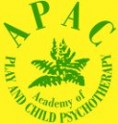How to train and register to work therapeutically with children. Also essay 'Autistic Children CAN Play and benefit therapeutically'
 Did you know that children on the autistic spectrum, contrary to widely held opinion, CAN PLAY and that there are big therapeutic benefits?
Did you know that children on the autistic spectrum, contrary to widely held opinion, CAN PLAY and that there are big therapeutic benefits?
- New career, new skills. Become registered to work therapeutically with children here:
- www.playtherapyregister.org.uk by training with APAC. 8 venues throughout the UK.
- See: www.playtherapy.org.uk email: This email address is being protected from spambots. You need JavaScript enabled to view it.
- Tel: 01825 761143
Autistic Children CAN Play and benefit therapeutically by Victoria Smith, a Certified Practitioner in Therapeutic Play Skills.
This article is an abridged version of a paper being published in 'Play for Life'. The journal of Play Therapy UK.
Over the last year, in my practice using therapeutic play I have been working mainly with children on the Autistic Spectrum. My colleagues embraced the idea of play therapy, however, one of the biggest challenges I have faced is the pre-conceived notion that children on the autistic spectrum are unable to play. There have been many occasions when a colleague has approached me and said 'I like the idea of play therapy but how will it work if the children don't know how to play?'
Play is a natural occurrence for most children. Typically developing children can be observed moving through the various stages of play development. Piaget was one of the first theorists to describe a developmental sequence in children's play that went from 'practice play' through 'symbolic play' to 'games with rules'. These children are able to add complexity, imagination and creativity to their thought processes and actions. In comparison to this, for many children on the autistic spectrum, the various stages of play do not fully develop or they occur in a fragmented fashion. It is not a case of children on the autistic spectrum can't play, but rather that their play gets stuck at the earlier stages practice play and early sensory motor play. They may not then develop symbolic play.
Children on the autistic spectrum are often under pressure to conform to 'social norms', however, in the playroom these children are free to be themselves. There is no pressure on them to play in a certain way or to communicate verbally with the therapist. Instead it is 40 minutes in which the child can use the playroom in the way that they wish to, they can play with what they like, speak if they wish or sit in silence; it is entirely up to the child. The therapist accepts them as they are, focuses closely upon them and reflects verbally only when it adds to the child's process.
An example of this is a child I worked with (H), had very little communication skills and preferred his own company. After a few weeks of play therapy H was beginning to take notice of other people in the room with him and was accepting them being near him. By the time our sessions came to an end he was actively pointing things out to his mum and teachers and was verbalising his needs outside the play room. He was a perfect example of how even though he did not play according to most people's typical ideas, he did play and play therapy was very effective for him.
The playroom itself may need to be adapted for children on the autistic spectrum. Walking into a room full of toys can be overwhelming for these children and could potentially result in them refusing to enter the room, or if they are able to enter may not be able to decide what to start with. This may end up with the child sitting at the first thing they see and then staying there for the duration of each session. The therapist might limit the items in the room depending on what they think will be suitable for the child and their needs.
Having the items in the same place each week is important for all children in play therapy but especially so for children on the autistic spectrum as order and routine is important to them, if something is not where they thought it would be, there is potential for the child to react negatively about this and they may refuse to come back to the playroom.
Another child I worked with recently, D, got stuck on small world toys; he was very reluctant to allow me to join his play and I was beginning to wonder if what I was doing was having any effect on him. I decided one day to attempt drawing with him, although unsure of how he would react to this I decided to go ahead and ended up with positive results. After several attempts of trying to introduce a new character into the play he eventually accepted me and allowed me to join his play. Although I was not directing the play, my presence in his play meant he was able to accept me and began to form a bond with me. This then allowed me to introduce further mediums into his repertoire and eventually opened up the whole playroom to him.
Play therapy can have huge benefits for children on the autistic spectrum. There have been many case studies over the years which have shown a positive effect on the children's behaviour and their ability to communicate with others. I personally have found that the children I have worked with have been able to communicate better both at home and at school, their behaviour has improved and they are forming better, more positive relationships with those around them.
As a Play Therapy UK Registrant I am required to carry out a clinical audit of my work, by using pre- and post-therapy measures using the Goodman SDQ Total Difficulties domain, the lower the scores the better. (A 'normal' child scores around 6 to 10, a child at risk over 28). The scores for H are: Teacher pre- 18 post- 12 Parent pre- 27 post- 24; for D: Teacher pre- 15 post- 8, Parent pre- 11 post- 6. These show a significant improvement.


